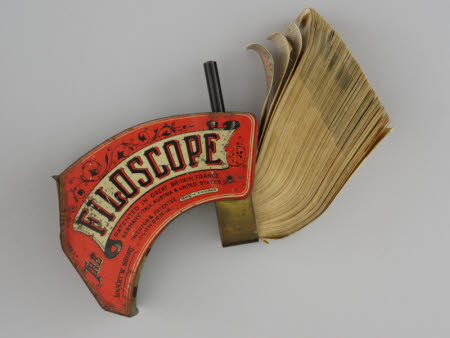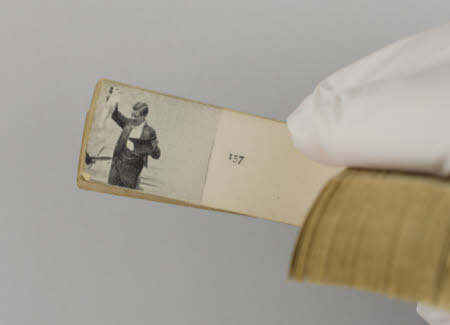A Filoscope depicting David Devant, the Conjurer.
Category
Photographs
Date
1897 - 1910
Materials
Paper
Measurements
60 x 90 x 24 mm
Order this imageCollection
Fox Talbot Museum, Wiltshire
NT 1521229
Summary
A Filoscope depicting David Devant, the Conjurer, of the Egyptian Hall. A series of 159 halftone prints of photographs in a flip book within an orange painted metal case with black, cream and orange text/design. The images depict a conjurer, David Devant, pulling a rabbit out of a hat. There are also several blank pages at front and back of the sequence. Invented by Robert W Paul's cameraman, Henry W Short, this was a small hand-held flip-book device, using a lever to flip over separate pictures to give the illusion of movement. Each filoscope contained a hundred or so frames reproduced from a professional film, many of them by Paul, a dominant figure in the early history of cinema in England. This one contains the earliest film of a conjuror, David Durant. The consecutive series of images are small halftone prints made from Paul's original negatives. The images of David Durant were taken on the roof of the Alhambra Theatre, London (see reference in General Note to book by John Barnes). Markings: On the metal case recto: "The Filoscope, patented in Great Britain, France, Germany, Italy, Austria & United States. Henry W Short, inventor & patentee - London. Made in England". On the metal case verso: Manufactured by license from the Mutoscope & Biograph Syndicate Ltd. for the United Kingdom". Markings on the front page of the flip book: "Subject - Mr David Devant, the Conjurer, of The Egyptian Hall". Page 2 has a detailed description of the conjuring trick depicted and Page 3 explains the production and use of the kinetic photograph system. The edges of the first 3 pages are damaged and have become detached.
Provenance
Part of the Fenton Collection. A gift from British Film Institute in 2017. From 1986-1999, part of BFI collection for the Museum of the Moving Image. BFI purchased collection in 1986 from James Fenton's Museum of Photography, Port Erin, Isle of Man 1976-1986.


